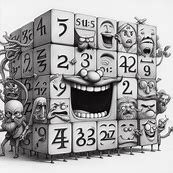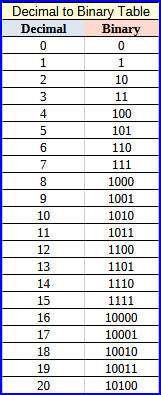Decimal to Binary

This Decimal to Binary Converter is a handy tool that can effortlessly convert decimal numbers into binary format. Input your decimal number, specify the number of decimal places (if applicable), and click "Convert" to instantly get the binary equivalent.
Decimal to binary conversion involves transforming a decimal (base-10) number into its binary (base-2) representation. In the binary system, each digit is either 0 or 1, and the positions of the digits represent powers of 2.
Decimal to Binary Converter
| Decimal: base10 | |
| Decimal Places: # | |
Result: | |
|
Convert decimal numbers to binary quickly and easily with our online tool.
Calculator
- enter any decimal number you wish to convert into binary
- specify the number of decimal places for precision
Result
- the binary equivalent of the entered decimal number
Here's how the conversion works:
Integer Part Conversion:
- Divide the decimal number by 2
- Record the remainder (0 or 1), representing the least significant bit (LSB)
- Repeat the division process with the quotient until it becomes zero
- The binary equivalent is obtained by reading the remainders in reverse order
Fractional Part Conversion (if applicable):
- Multiply the fractional part by 2
- Record the integer part of the result, which represents the next bit after the decimal point
- Repeat the multiplication process with the fractional part until it becomes zero or until the desired precision is reached.
Example Conversion:
Convert the decimal number 13.625 to binary.
Integer Part Conversion:
- Dividing 13 by 2, we get quotient 6 and remainder 1
- Dividing 6 by 2, we get quotient 3 and remainder 0
- Dividing 3 by 2, we get quotient 1 and remainder 1
- Dividing 1 by 2, we get quotient 0 and remainder 1
- Reading the remainders in reverse order: 1101
Fractional Part Conversion:
- Multiplying 0.625 by 2, we get 1.25, so the first bit after the decimal point is 1
- Multiplying 0.25 by 2, we get 0.5, so the next bit is 0
- Multiplying 0.5 by 2, we get 1, so the next bit is 1
- Multiplying 0 by 2, we get 0. (Terminating because no more precision is required)
Binary Equivalent:
Combining the integer and fractional parts, we get:- Integer part: 1101
- Fractional part: .101
- Binary equivalent: 1101.101
The decimal number 13.625 is equivalent to 1101.101 in binary notation.

Decimal System (Base-10) Calculators
Base Conversions:
- Decimal to Binary
- Decimal to Octal
- Decimal to One's and Two's Complement Binary
- Decimal to Other Bases
- Decimal to Hexadecimal
- Decimal Fraction to a Hexadecimal Fraction
Fraction and Mixed Number Operations:
- Decimal to Mixed Numbers
- Decimal Fraction to a Proper Fraction
- Fraction Addition
- Mixed Numbers and Fractions Addition
- Mixed Numbers and Fractions Addition - Multiples
- High-Precision Multiple Fraction Addition
- High-Precision Fraction Addition
- High-Precision Fraction Division
- High-Precision Fraction Subtraction
- High-Precision Fractional Exponentiation
- High-Precision Fraction Multiplication
- High-Precision Multiple Fraction Addition
Math Operations:
Number Theory:
- Coprime Checker
- GCD (Greatest Common Divisor)
- LCM (Least Common Multiple)
- Perfect Number
- ---- Prime Factorization
- ---- nth Root for Fractions
- ---- nth Root - Advanced